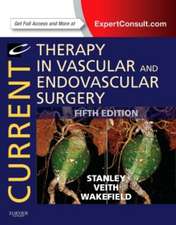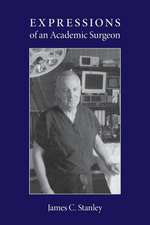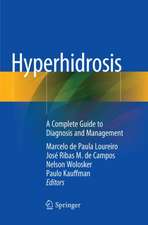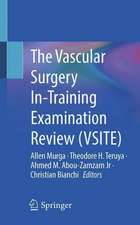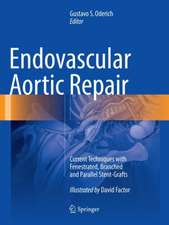Vascular Surgery in Oncology
Editat de Antonio Eduardo Zerati, Kenji Nishinari, Nelson Woloskeren Limba Engleză Paperback – 10 iun 2023
This book explores the interface between vascular surgery and the various clinical and surgical oncological specialties, highlighting which types of neoplasm are most common and focusing on those that more frequently cause or are influenced by vascular diseases. The diagnostic procedures for these tumors and the most suitable types of treatment are also discussed.
The content is divided into three sections: I – Surgical Oncology, II – Clinical Oncology and Oncohematology, and III – Vascular and Endovascular Surgery. The first section presents the most common types of tumor in each surgical oncology specialty, and the most frequent tumors associated with vascular complications. The diagnosis, staging, prognosis and oncological treatments are discussed, while associated vascular complications, such as vascular invasion, venous thrombosis, and arterial thrombosis, are described. The second section focuses on general aspects of Clinical Oncology and Oncohematology in addition to the most frequent vascular complications related to solid and hematological cancers and its treatment (chemotherapy, radiotherapy, bone marrow transplantation). The third section includes a more detailed approach to vascular events and diseases commonly found in cancer patients, in addition to technical discussions regarding vascular reconstructions associated with tumor resection, vascular access, among other topics.
At the end of each chapter, the editors comment and highlight the most important challenges for vascular surgeons who dedicate their lives to treating cancer patients.
Given its scope, the book offers a valuable resource for medical specialists and professionals in training in the fields of vascular surgery and angiology, clinical oncology, oncohematology and surgical oncology.
| Toate formatele și edițiile | Preț | Express |
|---|---|---|
| Paperback (1) | 944.99 lei 38-44 zile | |
| Springer International Publishing – 10 iun 2023 | 944.99 lei 38-44 zile | |
| Hardback (1) | 1444.39 lei 38-44 zile | |
| Springer International Publishing – 9 iun 2022 | 1444.39 lei 38-44 zile |
Preț: 944.99 lei
Preț vechi: 994.73 lei
-5% Nou
Puncte Express: 1417
Preț estimativ în valută:
180.82€ • 188.81$ • 149.32£
180.82€ • 188.81$ • 149.32£
Carte tipărită la comandă
Livrare economică 11-17 aprilie
Preluare comenzi: 021 569.72.76
Specificații
ISBN-13: 9783030976897
ISBN-10: 3030976890
Pagini: 575
Ilustrații: XIV, 575 p. 104 illus., 87 illus. in color.
Dimensiuni: 155 x 235 mm
Greutate: 1.1 kg
Ediția:1st ed. 2022
Editura: Springer International Publishing
Colecția Springer
Locul publicării:Cham, Switzerland
ISBN-10: 3030976890
Pagini: 575
Ilustrații: XIV, 575 p. 104 illus., 87 illus. in color.
Dimensiuni: 155 x 235 mm
Greutate: 1.1 kg
Ediția:1st ed. 2022
Editura: Springer International Publishing
Colecția Springer
Locul publicării:Cham, Switzerland
Cuprins
Part I – Surgical Oncology
Chapter 1 – Head and Neck Surgery
- Most common tumor types
- Types of tumor most frequently associated with vascular complications
• Diagnosis (image, AP, others)
• Staging / prognosis
• Oncological treatment (Chemotherapy? Radiotherapy? Surgical resection?) - general guidelines
• What vascular complications are associated with these tumor types (vascular invasion, venous thrombosis, arterial thrombosis)
• Vascular and endovascular topics in oncological Head and Neck Surgery– Editors comments
Chapter 2 – Thoracic Surgery
- Most common tumor types
- Types of tumor most frequently associated with vascular complications
• Diagnosis (image, AP, others)
• Staging / prognosis
• Oncological treatment (Chemotherapy? Radiotherapy? Surgical resection?) - general guidelines
• What vascular complications are associated with these tumor types (vascular invasion, venous thrombosis, arterial thrombosis)
• Vascular and endovascular topics in oncological Thoracic Surgery– Editors comments
Chapter 3 – Gastrointestinal Surgery
- Most common tumor types
- Types of tumor most frequently associated with vascular complications
• Diagnosis (image, AP, others)
• Staging / prognosis
• Oncological treatment (Chemotherapy? Radiotherapy? Surgical resection?) - general guidelines
• What vascular complications are associated with these tumor types (vascular invasion, venous thrombosis, arterial thrombosis)
• Vascular and endovascular topics in oncological Gastrointestinal Surgery– Editors comments
Chapter 4 – Urology
- Most common tumor types
- Types of tumor most frequently associated with vascular complications
• Diagnosis (image, AP, others)
• Staging / prognosis
• Oncological treatment (Chemotherapy? Radiotherapy? Surgical resection?) - general guidelines
• What vascular complications are associated with these tumor types (vascular invasion, venous thrombosis, arterial thrombosis)
• Vascular and endovascular topics in oncological Urology – Editors comments
Chapter 5 – Gynecology / Mastology
- Most common tumor types
- Types of tumor most frequently associated with vascular complications
• Diagnosis (image, AP, others)
• Staging / prognosis
• Oncological treatment (Chemotherapy? Radiotherapy? Surgical resection?) - general guidelines
• What vascular complications are associated with these tumor types (vascular invasion, venous thrombosis, arterial thrombosis)
• Vascular and endovascular topics in oncological Gynecology and Mastology – Editors comments
Chapter 6 – Orthopedics
- Most common tumor types
- Types of tumor most frequently associated with vascular complications
• Diagnosis (image, AP, others)
• Staging / prognosis
• Oncological treatment (Chemotherapy? Radiotherapy? Surgical resection?) - general guidelines
• What vascular complications are associated with these tumor types (vascular invasion, venous thrombosis, arterial thrombosis)
•Surgical anatomy and approaches to the anterior thoracolumbar spine region
• Vascular and endovascular topics in oncological Orthopedics – Editors comments
Chapter 7 – Retroperitoneal Tumors
- Most common tumor types
- Types of tumor most frequently associated with vascular complications • Diagnosis (image, AP, others)
• Staging / prognosis
• Oncological treatment (Chemotherapy? Radiotherapy? Surgical resection?) - general guidelines
• What vascular complications are associated with these tumor types (vascular invasion, venous thrombosis, arterial thrombosis)
• Vascular and endovascular topics in oncological Retroperitoneal Surgery– Editors comments
Chapter 8 – Neurosurgery
- Most common tumor types
- Types of tumor most frequently associated with vascular complications
• Diagnosis (image, AP, others)
• Staging / prognosis
• Oncological treatment (Chemotherapy? Radiotherapy? Surgical resection?) - general guidelines
• What vascular complications are associated with these tumor types (vascular invasion, venous thrombosis, arterial thrombosis)
• Venous thromboembolism – when anticoagulation is not allowed
• Vascular and endovascular topics in oncological Neurosurgery– Editors comments
Part II – Clinical Oncology and Oncohematology
Chapter 9 – Clinical Oncology
- Types of chemotherapy - general concepts
- Tumor types most associated with vascular complications (VTE, arterial thrombosis)
- More frequent vascular complications with chemotherapy (VTE, arterial thrombosis, thrombocytopenia, neutropenia, others) - which drugs, in which phase between cycles
- Criteria for choosing vascular access for chemotherapy treatment (peripheral, PICC, Port) - Oncologist's view
• Vascular and endovascular topics in Clinical Oncology – Editors comments
Chapter 10 – Oncohematology
- More frequent tumor types (leukemias, lymphomas, multiple myeloma)
- Most used chemotherapeutic agents– general concepts
- Tumor types most associated with vascular complications (compression mediastinum vessels, VTE, arterial thrombosis, acute leukosis)
- Most frequent vascular complications related to chemotherapy (VTE, arterial thrombosis, thrombocytopenia, neutropenia, others) - which drugs, in which phase between cycles
- Criteria for choosing vascular access for chemotherapy (peripheral, PICC, Port, Hickman, Permcath) – Oncohematologist’s point of view
- Bone marrow transplantation (autologous / halogenic, how it is done, indications, care)
• Vascular and endovascular topics in Oncohematology – Editors comments
Part III – Vascular and Endovascular Surgery
Chapter 11 – VTE and Cancer
- Epidemiology
- Diagnosis - laboratory, image
- Prophylaxis
· Clinical patient
· Surgical patient
- Treatment of VTE in cancer patients
- Drugs (conventional drugs, NOACs)
- Treatment extension (full dose, reduced dose, criteria for suspension / reduction)
- Follow-up
- Surgical treatment (indications, how it is done)
- Vena cava filter (definitive / removable)
- Fibrinolysis
- Mechanical thrombectomy
Chapter 12 – Endovascular Procedures in Cancer Patients
- Chemoembolization of liver tumors
- Embolization of vascular malformations
- Embolization of bleeding sites
Chapter 13 – Lymphatic Disorders in Oncological Patients
- Lymphatic vessels anatomy
- Lymphedema in cancer patients
- Diagnosis
- Clinical treatment
- Surgical treatment
Chapter 14 – Vascular Access
- Types of vascular access
- Peripherals, PICC, port, hickman, permcath
- Implant technique
- Infectious complications
- Non-infectious complications
- Nursing care
- Puncture technique
- Maintenance (heparinization / salinization - port, permcath, PICC)
- What is an adequate access? Nursing view
Chapter 1 – Head and Neck Surgery
- Most common tumor types
- Types of tumor most frequently associated with vascular complications
• Diagnosis (image, AP, others)
• Staging / prognosis
• Oncological treatment (Chemotherapy? Radiotherapy? Surgical resection?) - general guidelines
• What vascular complications are associated with these tumor types (vascular invasion, venous thrombosis, arterial thrombosis)
• Vascular and endovascular topics in oncological Head and Neck Surgery– Editors comments
Chapter 2 – Thoracic Surgery
- Most common tumor types
- Types of tumor most frequently associated with vascular complications
• Diagnosis (image, AP, others)
• Staging / prognosis
• Oncological treatment (Chemotherapy? Radiotherapy? Surgical resection?) - general guidelines
• What vascular complications are associated with these tumor types (vascular invasion, venous thrombosis, arterial thrombosis)
• Vascular and endovascular topics in oncological Thoracic Surgery– Editors comments
Chapter 3 – Gastrointestinal Surgery
- Most common tumor types
- Types of tumor most frequently associated with vascular complications
• Diagnosis (image, AP, others)
• Staging / prognosis
• Oncological treatment (Chemotherapy? Radiotherapy? Surgical resection?) - general guidelines
• What vascular complications are associated with these tumor types (vascular invasion, venous thrombosis, arterial thrombosis)
• Vascular and endovascular topics in oncological Gastrointestinal Surgery– Editors comments
Chapter 4 – Urology
- Most common tumor types
- Types of tumor most frequently associated with vascular complications
• Diagnosis (image, AP, others)
• Staging / prognosis
• Oncological treatment (Chemotherapy? Radiotherapy? Surgical resection?) - general guidelines
• What vascular complications are associated with these tumor types (vascular invasion, venous thrombosis, arterial thrombosis)
• Vascular and endovascular topics in oncological Urology – Editors comments
Chapter 5 – Gynecology / Mastology
- Most common tumor types
- Types of tumor most frequently associated with vascular complications
• Diagnosis (image, AP, others)
• Staging / prognosis
• Oncological treatment (Chemotherapy? Radiotherapy? Surgical resection?) - general guidelines
• What vascular complications are associated with these tumor types (vascular invasion, venous thrombosis, arterial thrombosis)
• Vascular and endovascular topics in oncological Gynecology and Mastology – Editors comments
Chapter 6 – Orthopedics
- Most common tumor types
- Types of tumor most frequently associated with vascular complications
• Diagnosis (image, AP, others)
• Staging / prognosis
• Oncological treatment (Chemotherapy? Radiotherapy? Surgical resection?) - general guidelines
• What vascular complications are associated with these tumor types (vascular invasion, venous thrombosis, arterial thrombosis)
•Surgical anatomy and approaches to the anterior thoracolumbar spine region
• Vascular and endovascular topics in oncological Orthopedics – Editors comments
Chapter 7 – Retroperitoneal Tumors
- Most common tumor types
- Types of tumor most frequently associated with vascular complications • Diagnosis (image, AP, others)
• Staging / prognosis
• Oncological treatment (Chemotherapy? Radiotherapy? Surgical resection?) - general guidelines
• What vascular complications are associated with these tumor types (vascular invasion, venous thrombosis, arterial thrombosis)
• Vascular and endovascular topics in oncological Retroperitoneal Surgery– Editors comments
Chapter 8 – Neurosurgery
- Most common tumor types
- Types of tumor most frequently associated with vascular complications
• Diagnosis (image, AP, others)
• Staging / prognosis
• Oncological treatment (Chemotherapy? Radiotherapy? Surgical resection?) - general guidelines
• What vascular complications are associated with these tumor types (vascular invasion, venous thrombosis, arterial thrombosis)
• Venous thromboembolism – when anticoagulation is not allowed
• Vascular and endovascular topics in oncological Neurosurgery– Editors comments
Part II – Clinical Oncology and Oncohematology
Chapter 9 – Clinical Oncology
- Types of chemotherapy - general concepts
- Tumor types most associated with vascular complications (VTE, arterial thrombosis)
- More frequent vascular complications with chemotherapy (VTE, arterial thrombosis, thrombocytopenia, neutropenia, others) - which drugs, in which phase between cycles
- Criteria for choosing vascular access for chemotherapy treatment (peripheral, PICC, Port) - Oncologist's view
• Vascular and endovascular topics in Clinical Oncology – Editors comments
Chapter 10 – Oncohematology
- More frequent tumor types (leukemias, lymphomas, multiple myeloma)
- Most used chemotherapeutic agents– general concepts
- Tumor types most associated with vascular complications (compression mediastinum vessels, VTE, arterial thrombosis, acute leukosis)
- Most frequent vascular complications related to chemotherapy (VTE, arterial thrombosis, thrombocytopenia, neutropenia, others) - which drugs, in which phase between cycles
- Criteria for choosing vascular access for chemotherapy (peripheral, PICC, Port, Hickman, Permcath) – Oncohematologist’s point of view
- Bone marrow transplantation (autologous / halogenic, how it is done, indications, care)
• Vascular and endovascular topics in Oncohematology – Editors comments
Part III – Vascular and Endovascular Surgery
Chapter 11 – VTE and Cancer
- Epidemiology
- Diagnosis - laboratory, image
- Prophylaxis
· Clinical patient
· Surgical patient
- Treatment of VTE in cancer patients
- Drugs (conventional drugs, NOACs)
- Treatment extension (full dose, reduced dose, criteria for suspension / reduction)
- Follow-up
- Surgical treatment (indications, how it is done)
- Vena cava filter (definitive / removable)
- Fibrinolysis
- Mechanical thrombectomy
Chapter 12 – Endovascular Procedures in Cancer Patients
- Chemoembolization of liver tumors
- Embolization of vascular malformations
- Embolization of bleeding sites
Chapter 13 – Lymphatic Disorders in Oncological Patients
- Lymphatic vessels anatomy
- Lymphedema in cancer patients
- Diagnosis
- Clinical treatment
- Surgical treatment
Chapter 14 – Vascular Access
- Types of vascular access
- Peripherals, PICC, port, hickman, permcath
- Implant technique
- Infectious complications
- Non-infectious complications
- Nursing care
- Puncture technique
- Maintenance (heparinization / salinization - port, permcath, PICC)
- What is an adequate access? Nursing view
Notă biografică
Dr. Antonio Eduardo Zerati received his medical degree from the University of São Paulo Medical School in 1996. He completed his residency in Vascular Surgery at the Hospital das Clínicas of the University of São Paulo Medical School in 2001 and received his PhD in medicine (Clinical Surgery) from the University of São Paulo in 2011. He is currently head of the Vascular and Endovascular Team at the São Paulo State Cancer Institute (Instituto do Câncer do Estado de São Paulo – ICESP), Hospital das Clínicas of the University of São Paulo Medical School and a Professor at the University of São Paulo Medical School. Dr. Zerati is also a researcher with more than 50 published papers on vascular and endovascular surgery, many of which related to cancer. He is a member of the Brazilian Society of Angiology and Vascular Surgery and the Society of Vascular Surgery (USA).
Dr. Kenji Nishinari received his medical degree from the University of São Paulo Medical School in 1992. He completed his residency in vascular surgery at the Hospital das Clínicas of the University of São Paulo Medical School in 1996, and received his PhD in Vascular Surgery from the University of São Paulo Medical School in 2006. He is currently a Professor at the Department of Vascular and Endovascular Surgery at the AC Camargo Cancer Center and an Assistant Professor at the Hospital Alemão Oswaldo Cruz, São Paulo. He is a member of the Brazilian Society of Angiology and Vascular Surgery.
Dr. Nelson Wolosker received his medical degree from the Santa Casa of São Paulo Medical Science College in 1984. He completed his residency in vascular surgery at the Hospital das Clínicas of the University of São Paulo Medical School in 1986, and received his PhD in medicine (Clinical Surgery) from the University of São Paulo in 1997. He is currently Vice President of Research and Innovation at the Hospital Israelita Albert Einstein. He is a Full Professor at the Hospital Israelita Albert Einstein Medical School and an Associate Professor at the University of São Paulo Medical School. Dr. Wolosker is also a researcher with more than 300 published papers on vascular and endovascular surgery, intermittent claudication and hyperhidrosis.
Dr. Kenji Nishinari received his medical degree from the University of São Paulo Medical School in 1992. He completed his residency in vascular surgery at the Hospital das Clínicas of the University of São Paulo Medical School in 1996, and received his PhD in Vascular Surgery from the University of São Paulo Medical School in 2006. He is currently a Professor at the Department of Vascular and Endovascular Surgery at the AC Camargo Cancer Center and an Assistant Professor at the Hospital Alemão Oswaldo Cruz, São Paulo. He is a member of the Brazilian Society of Angiology and Vascular Surgery.
Dr. Nelson Wolosker received his medical degree from the Santa Casa of São Paulo Medical Science College in 1984. He completed his residency in vascular surgery at the Hospital das Clínicas of the University of São Paulo Medical School in 1986, and received his PhD in medicine (Clinical Surgery) from the University of São Paulo in 1997. He is currently Vice President of Research and Innovation at the Hospital Israelita Albert Einstein. He is a Full Professor at the Hospital Israelita Albert Einstein Medical School and an Associate Professor at the University of São Paulo Medical School. Dr. Wolosker is also a researcher with more than 300 published papers on vascular and endovascular surgery, intermittent claudication and hyperhidrosis.
Textul de pe ultima copertă
Circulatory conditions are involved both in the oncologic disease itself and in its treatment, with a direct impact on therapeutic planning for patients. At the same time, it goes without saying that cancer and its treatment affect the circulatory system, be it arterial, venous or lymphatic.
This book explores the interface between vascular surgery and the various clinical and surgical oncological specialties, highlighting which types of neoplasm are most common and focusing on those that more frequently cause or are influenced by vascular diseases. The diagnostic procedures for these tumors and the most suitable types of treatment are also discussed.
The content is divided into three sections: I – Surgical Oncology, II – Clinical Oncology and Oncohematology, and III – Vascular and Endovascular Surgery. The first section presents the most common types of tumor in each surgical oncology specialty, and the most frequent tumors associated with vascular complications. The diagnosis, staging, prognosis and oncological treatments are discussed, while associated vascular complications, such as vascular invasion, venous thrombosis, and arterial thrombosis, are described. The second section focuses on general aspects of Clinical Oncology and Oncohematology in addition to the most frequent vascular complications related to solid and hematological cancers and its treatment (chemotherapy, radiotherapy, bone marrow transplantation). The third section includes a more detailed approach to vascular events and diseases commonly found in cancer patients, in addition to technical discussions regarding vascular reconstructions associated with tumor resection, vascular access, among other topics.
At the end of each chapter, the editors comment and highlight the most important challenges for vascular surgeons who dedicate their lives to treating cancer patients.
Given its scope, the book offers a valuable resource for medical specialists and professionals in training in the fields of vascular surgery and angiology, clinical oncology, oncohematology and surgical oncology.
This book explores the interface between vascular surgery and the various clinical and surgical oncological specialties, highlighting which types of neoplasm are most common and focusing on those that more frequently cause or are influenced by vascular diseases. The diagnostic procedures for these tumors and the most suitable types of treatment are also discussed.
The content is divided into three sections: I – Surgical Oncology, II – Clinical Oncology and Oncohematology, and III – Vascular and Endovascular Surgery. The first section presents the most common types of tumor in each surgical oncology specialty, and the most frequent tumors associated with vascular complications. The diagnosis, staging, prognosis and oncological treatments are discussed, while associated vascular complications, such as vascular invasion, venous thrombosis, and arterial thrombosis, are described. The second section focuses on general aspects of Clinical Oncology and Oncohematology in addition to the most frequent vascular complications related to solid and hematological cancers and its treatment (chemotherapy, radiotherapy, bone marrow transplantation). The third section includes a more detailed approach to vascular events and diseases commonly found in cancer patients, in addition to technical discussions regarding vascular reconstructions associated with tumor resection, vascular access, among other topics.
At the end of each chapter, the editors comment and highlight the most important challenges for vascular surgeons who dedicate their lives to treating cancer patients.
Given its scope, the book offers a valuable resource for medical specialists and professionals in training in the fields of vascular surgery and angiology, clinical oncology, oncohematology and surgical oncology.
Caracteristici
Explores the interface of vascular surgery and oncological diseases in a comprehensive and detailed format
Describes circulatory, arterial, venous and lymphatic intercurrences during oncological treatment
Focuses on a subject of growing interest and importance for cancerologists and vascular surgeons
Describes circulatory, arterial, venous and lymphatic intercurrences during oncological treatment
Focuses on a subject of growing interest and importance for cancerologists and vascular surgeons


